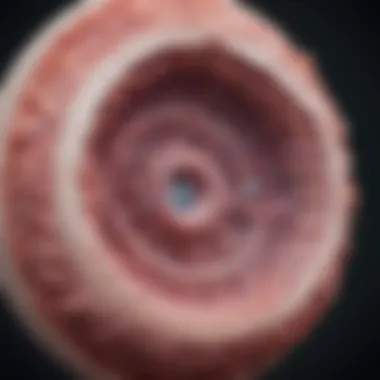Signet Ring Cell Carcinoma of the Stomach: Insights


Intro
Signet ring cell carcinoma of the stomach is a rare but alarming type of gastric cancer. This malignancy's distinct characteristics make it a significant focus for both researchers and practitioners in oncology. Its diagnosis often comes too late, leading to a poor prognosis. Understanding the nuances of this condition is crucial for improving treatment outcomes.
Research Overview
Summary of Key Findings
Recent studies show that signet ring cell carcinoma is associated with a unique histopathological appearance. Tumors are dominated by signet ring cells, which are characterized by large mucin-filled vacuoles. This specific cellular morphology contributes to the cancer's aggressive nature and atypical manifestation within the stomach and potentially surrounding tissues. Patients diagnosed with this type often exhibit advanced disease stages upon initial diagnosis, making early detection exceedingly complex.
Background and Context
Signet ring cell carcinoma accounts for approximately 1-3% of all gastric carcinomas. It is more prevalent in certain populations and demographics, including younger patients and females. The biological behavior of this cancer raises concerns regarding traditional treatment approaches, which may not adequately address its unique challenges. Comprehensive research into its molecular biology could lead to more effective therapies and improved patient care.
Methodology
Experimental Design
The research on signet ring cell carcinoma often involves a combination of retrospective analysis of clinical data and prospective studies aimed at understanding the disease's behavior. This multifaceted approach allows researchers to correlate histopathological findings with clinical outcomes effectively.
Data Collection Techniques
Data collection for studies on SRCC typically includes:
- Histological analysis: Utilizing biopsy samples to observe signet ring cell characteristics.
- Imaging studies: Employing modalities like CT scans and MRIs to assess tumor spread.
- Clinical trials: Collecting patient outcomes from novel therapies targeting this aggressive cancer.
Given its aggressive nature, the ongoing study of SRCC is vital for developing targeted treatments. The knowledge gained from recent research can finally bridge the existing gap in diagnostic and therapeutic practices.
Preamble to Signet Ring Cell Carcinoma
Understanding signet ring cell carcinoma (SRCC) is paramount due to its unique characteristics and clinical implications. This subtype of gastric cancer is distinguished by its histopathological features, and it presents distinct challenges in diagnosis and treatment. The complexity of SRCC necessitates a thorough exploration, focusing on definitions, classifications, epidemiology, and incidence rates. The insights obtained from this examination are critical for medical professionals, as they pave the way for more informed decision-making in clinical practices.
Definition and Classification
Signet ring cell carcinoma is a rare and aggressive form of gastric cancer. It is characterized by the presence of signet ring cells within the tumor. These cells are abnormal and contain a large vacuole that displaces the nucleus, giving them a ring-like appearance under the microscope. SRCC can be classified into two primary categories based on its association with other types of malignancies: primary and secondary. Primary SRCC occurs in the stomach and accounts for the majority of cases, while secondary SRCC can arise from other sites, such as breast or colon cancer, metastasizing to the gastric region. Understanding this classification aids in the assessment of the disease's origin and treatment strategies proposed for patients.
Epidemiology and Incidence
Examining the epidemiology of signet ring cell carcinoma reveals valuable insights into its prevalence and risk factors. SRCC is notably more common in younger individuals compared to other forms of gastric cancers. Demographically, it has a higher incidence in women and often presents at advanced stages, complicating treatment options. According to various studies, SRCC accounts for approximately 1-3% of all gastric cancers, although its incidence has shown a rising trend in certain populations. Risk factors include genetic predisposition, dietary habits, and environmental influences, making it essential for ongoing research to comprehend fully the underlying causes of this distinct carcinoma.
"The distinct characteristics of signet ring cell carcinoma necessitate a nuanced understanding of its epidemiology to develop targeted and effective management strategies."
Understanding both the definition and classification alongside the epidemiology and incidence of SRCC provides the groundwork for exploring the subsequent sections of diagnosis, clinical presentation, treatment strategies, and advances in research pertaining to this aggressive malignancy. Such knowledge ensures that healthcare professionals can tailor treatments effectively, emphasizing the need for thorough and ongoing education in this field.
Histopathological Features
The histopathological characteristics of signet ring cell carcinoma (SRCC) play a pivotal role in understanding this distinct subtype of gastric cancer. Identifying these features is crucial for accurate diagnosis, influencing treatment decisions and providing insight into the tumor's behavior. Histopathological examination allows pathologists and oncologists to differentiate SRCC from other types of gastric tumors, guiding effective management strategies.
Morphology of Signet Ring Cells
Signet ring cells are named for their unique appearance, resembling a signet ring. These cells are characterized by a prominent cytoplasmic mucin droplet that pushes the nucleus to one side, leading to a distinctive "ring" shape. This morphology is an essential diagnostic feature. In SRCC, these neoplastic signet ring cells infiltrate the gastric wall extensively, contributing to the diffuse nature of the disease.
Pathologists usually observe the tumor at the histological level using hematoxylin and eosin staining. Invasion of signet ring cells may lead to a desmoplastic reaction, giving rise to a fibrous stroma. The presence of these cells in histopathological samples is a strong indicator of SRCC, as they are not typically found in other types of gastric cancers. Understanding the morphology provides clues about the tumor's progression and potential response to therapies.


Differential Diagnosis
The differential diagnosis of SRCC is challenging due to similar histological features shared with other gastric cancers. Accurate identification is necessitated by the influence on treatment and prognosis. Key conditions to differentiate include:
- Differentiated Adenocarcinomas: Typically have a clear glandular structure, contrasting with the infiltrative pattern seen in SRCC.
- Lymphoma: Can also present with diffuse infiltration but lacks the distinct signet ring morphology.
- Other Subtypes of Gastric Cancer: Such as poorly differentiated adenocarcinoma, which may exhibit cellular atypia without the typical signet appearance.
A comprehensive histopathological evaluation, often combined with immunohistochemical staining, is essential to appreciate the nuances between these conditions. Markers such as cytokeratin and mucin stains can assist in confirming the diagnosis and guide further management.
Understanding the unique histopathological characteristics of SRCC is essential in forming a strong foundation for effective diagnosis and treatment.
Clinical Presentation
The clinical presentation of signet ring cell carcinoma (SRCC) holds significant importance in understanding this gastric malignancy. Early recognition of symptoms and relevant prognostic factors can be crucial for timely intervention and effective management. The distinct characteristics of SRCC not only influence patient outcomes but also guide clinicians in their approach to diagnosis and treatment. By focusing on the clinical aspects of this cancer type, healthcare providers can enhance their readiness to manage this aggressive form of gastric cancer.
Symptoms and Signs
Patients with signet ring cell carcinoma often present with vague symptoms in the initial stages. Common presentations include:
- Abdominal discomfort: Patients may experience persistent pain, discomfort, or a feeling of fullness.
- Nausea and vomiting: These symptoms can be indicative of gastric obstruction and are often reported.
- Weight loss: Unintentional weight loss is frequently noted, which may stem from decreased appetite or difficulty eating.
- Dysphagia: Patients may report difficulty swallowing as the tumor progresses.
- Anemia: Chronic blood loss from the tumor can lead to anemia, presenting as fatigue and weakness.
The insidious onset of these symptoms often leads to delays in diagnosis. This delayed recognition underscores the need for vigilance among healthcare practitioners, especially in high-risk populations.
Prognostic Factors
Several prognostic factors are crucial in evaluating the clinical outcomes of patients with signet ring cell carcinoma. Some of these include:
- Tumor stage: The extent of tumor invasion, lymph node involvement, and presence of metastatic disease significantly affect survival rates.
- Histological grade: Differentiation of tumor cells impacts the aggressiveness and treatment response of the cancer.
- Patient age and health status: Younger, healthier patients generally have better prognosis compared to older patients with comorbidities.
- Biomarkers: Certain genetic mutations and protein expressions may inform treatment choices and predict responses to therapy.
Evaluating these factors helps establish treatment plans and provides insights into expected outcomes for individual patients.
Timely assessment of clinical presentation in SRCC is fundamental for improving patient care and survival rates.
Understanding the clinical presentation of signet ring cell carcinoma allows for more effective patient management. By appreciating the ongoing developments in diagnosis and treatment, practitioners can better address the needs of patients suffering from this challenging subtype of gastric cancer.
Diagnosis of Signet Ring Cell Carcinoma
The diagnosis of signet ring cell carcinoma (SRCC) is critical for determining appropriate treatment and managing patient outcomes effectively. Due to its unique histopathological characteristics and aggressive nature, accurate diagnosis plays a vital role in the clinical pathway. The challenge lies in distinguishing SRCC from other gastric carcinomas, as the symptoms may overlap with various other gastrointestinal disorders. Therefore, a comprehensive approach that combines multiple diagnostic modalities is essential.
Imaging Techniques
Imaging techniques are essential for initial assessment and staging of signet ring cell carcinoma. Several modalities are used, each with its unique advantages. These include:
- Computed Tomography (CT) Scans: CT provides cross-sectional images of the abdomen, aiding in tumor localization and nodal involvement assessment.
- Magnetic Resonance Imaging (MRI): MRI can be useful, particularly for evaluating soft tissue involvement and understanding the extent of the disease.
- Endoscopic Ultrasound (EUS): EUS allows for detailed visualization of the gastric wall layers and adjacent structures, improving accuracy in staging.
By integrating these imaging modalities, physicians can gather valuable information for effective diagnosis. This multi-faceted approach is crucial because early identification of SRCC may influence treatment decisions, for example, if a surgical approach is feasible rather than relying on palliative care.
Biopsy and Histological Analysis
Following imaging, biopsy remains the definitive method for diagnosing signet ring cell carcinoma. Histological analysis reveals the characteristic signet ring cells, which are key in confirming the diagnosis.
- Types of Biopsy: Several biopsy types can be used, including endoscopic biopsy and fine needle aspiration (FNA). Endoscopic biopsy is more common for gastric mass lesions.
- Histological Examination: Pathological review involves staining techniques such as hematoxylin and eosin (H&E), which helps visualize the unique morphology of signet ring cells. These cells have a cytoplasmic mucin that displaces the nucleus, creating their characteristic appearance.
- Immunohistochemistry: This technique can further support the diagnosis by assessing specific cellular markers, which help differentiate SRCC from other gastric cancers.
Accurate histological diagnosis of SRCC is crucial, as this subtype often correlates with a poorer prognosis due to its invasive nature.
The integration of imaging techniques and biopsy results forms a comprehensive diagnostic framework that is essential for managing patients with signet ring cell carcinoma. Early diagnosis not only impacts treatment planning but also shapes the overall management strategy, affecting the prognosis and quality of life for patients.


Molecular Pathogenesis
The molecular pathogenesis of signet ring cell carcinoma (SRCC) is pivotal to understanding its aggressive nature and associated poor prognosis. This exploration focuses on the genetic and molecular alterations that underlie the development and progression of this specific gastric cancer subtype. Understanding these processes is essential for clinicians and researchers, as they can offer insights into tailored therapies and better management strategies. Advances in molecular biology have illuminated aspects of SRCC that influence diagnosis, treatment, and outcomes.
Genetic Alterations
Genetic alterations are a hallmark of signet ring cell carcinoma. Research has shown that specific mutations frequently occur in SRCC, which differ from those seen in other gastric cancer types. Notably, chromosomal instability often occurs, leading to an abnormal number of chromosomes.
Key genetic mutations encompass:
- CD (E-cadherin): Mutations in the CD gene are prevalent, leading to disrupted cell adhesion and increased invasiveness of cancer cells.
- TP53: Alterations in the TP53 gene can result in the loss of tumor suppressor functions, promoting uncontrolled cell growth.
- HER2: Amplification of the HER2 gene may occur, which can make therapies targeting HER2 effective in some SRCC patients.
Understanding these genetic modifications offers pathways for both predictive diagnostics and targeted therapies. Furthermore, hereditary syndromes such as familial gastric cancer linked to CD mutations highlight the need for genetic counseling in at-risk families.
Signaling Pathways Involved
The signaling pathways involved in the pathogenesis of signet ring cell carcinoma contribute significantly to its malignancy and progression. Several critical pathways promote cancer cell growth and survival. The most notable among these are:
- PI3K/AKT/mTOR Pathway: This pathway is often activated in SRCC, supporting cancer cell proliferation, survival, and metabolism.
- Wnt/β-catenin Pathway: Dysregulation of this pathway affects cellular adhesion and contributes to the invasive properties typical of SRCC.
- MAPK Pathway: This signaling cascade is involved in cell division and differentiation, often leading to poor prognosis when aberrantly activated in cancer cells.
Each of these signaling pathways presents potential targets for therapeutic intervention. Understanding these pathways enhances our comprehension of the disease process and may guide future treatments, drastically affecting patient outcomes.
"Molecular insights into signet ring cell carcinoma allow for more informed decisions in clinical practice, paving the way for novel treatment strategies."
Treatment Strategies
The management of signet ring cell carcinoma (SRCC) in the stomach presents unique challenges due to its aggressive nature and distinct biological behavior. The significance of outlining effective treatment strategies is paramount for improving patient outcomes. In this section, we will explore surgical intervention, chemotherapy and targeted therapy, and radiation therapy.
Surgical Intervention
Surgical intervention remains a cornerstone in the treatment of SRCC. Given the tumor's infiltration pattern, complete surgical resection is often difficult. However, when possible, radical gastrectomy can provide the best chance for long-term survival. The complexity of these procedures necessitates the involvement of skilled surgical teams familiar with the nuances of gastric cancers. Importantly, preoperative staging is crucial to determine resectability and tailor the surgical approach accordingly.
A focus on optimization of surgical techniques can lead to improved outcomes. Minimally invasive techniques such as laparoscopic surgery have gained traction, but their applicability in SRCC needs further investigation. Post-operative care also plays a significant role, particularly regarding nutritional support and management of complications.
Chemotherapy and Targeted Therapy
Chemotherapy is often employed when the disease has advanced beyond the stage suitable for surgery. It aims to reduce tumor burden and prevent recurrence. Drugs such as cisplatin and 5-fluorouracil have traditionally been used, but response rates vary significantly in SRCC due to its unique molecular profile. This variability underscores the importance of genomic profiling to guide treatment choices. Targeted therapies are gaining attention, with options that focus on specific molecular pathways implicated in SRCC. Important pathways include the HER2/neu and the PD-1/PD-L1 axes, which can inform the use of agents like trastuzumab.
"Understanding the molecular landscape of signet ring cell carcinoma can direct more effective therapy approaches."
In clinical practice, the integration of chemotherapy with targeted therapies represents a promising avenue in the management of SRCC. However, careful assessment of potential side effects and drug interactions must guide treatment planning.
Radiation Therapy
Radiation therapy serves a complementary role in the management of SRCC, particularly for palliative purposes and in unresectable cases. It can be effective in reducing local symptoms, such as pain or obstruction. The role of radiation is also being reevaluated in the context of adjuvant settings, where it may help decrease recurrence rates post-surgery.
The decision to utilize radiation therapy must incorporate individual patient characteristics and the overall treatment plan. Advancements in techniques, including intensity-modulated radiation therapy, may enhance precision and reduce collateral damage to adjacent structures. As such, ongoing research into the optimal use of radiation therapy for SRCC is essential.
Recent Advances in Research
Research on signet ring cell carcinoma (SRCC) of the stomach has gained prominence due to its aggressive nature and distinct histopathological features. Understanding these advances is crucial not only for researchers but also for clinical practitioners striving to improve treatment outcomes. Recent advances in research reflect the evolving landscape of therapeutic options and diagnostic techniques, seeking to address the complexities of SRCC. These advancements include novel therapeutic approaches and insights from ongoing clinical trials, shaping future management strategies for this malignancy.
Novel Therapeutic Approaches


In the quest for effective treatment of SRCC, researchers are exploring various novel therapeutic approaches. One such approach is immunotherapy, which focuses on harnessing the body’s immune system to fight cancer. Drugs like pembrolizumab and nivolumab have shown promise in early studies, particularly in patients with high levels of microsatellite instability.
Chemotherapy regimens have also been revised. Specific combinations of agents such as trastuzumab, in conjunction with chemotherapy, have shown effectiveness in HER2-positive SRCC. Targeted therapies that concentrate on genetic mutations associated with SRCC are also gaining traction. Among them, agents that inhibit targeting molecular pathways could yield better responses in patients with specific genetic alterations.
“The potential of novel therapies offers hope for more tailored and effective treatment plans.”
Furthermore, research into epigenetic modifications provides insights into how tumor microenvironments may affect treatment responses. This understanding could lead to combination therapies that incorporate epigenetic modulators to enhance the efficacy of existing treatment options.
Clinical Trials and Outcomes
Clinical trials play a vital role in evaluating the effectiveness of new treatments for SRCC. They provide critical data that informs clinical practice. Current clinical trials are investigating both established and emerging therapies, focusing on overall survival rates and quality of life metrics for patients.
Patients enrolled in trials often have access to cutting-edge treatments not available through standard therapies. Significant recent trials include combination therapies that might involve chemotherapy and immunotherapy, aiming to improve outcomes for individuals diagnosed with SRCC.
The outcomes of these trials are being closely monitored, with researchers analyzing response rates and adverse effects. This data can lead to more precise and safer treatment strategies tailored to the individual’s cancer profile. As results emerge, they will not only clarify the effectiveness of new modalities but will also help refine existing protocols.
Advancements in imaging technologies, such as PET scans and liquid biopsies, are also under investigation to improve diagnosis and treatment monitoring. The incorporation of these technology-driven strategies is crucial for enhancing patient management.
Overall, the landscape of SRCC research is changing. The commitment to understanding this rare and aggressive cancer leads to better insights and more innovative treatment options. Such advances hold promise for improving the prognosis and quality of life for patients affected by signet ring cell carcinoma.
Survivorship and Quality of Life
The concept of survivorship encompasses the experiences and challenges faced by patients after a diagnosis of a serious illness, such as signet ring cell carcinoma (SRCC) of the stomach. Quality of life is a pivotal element in survivorship, as it reflects the overall well-being and life satisfaction of individuals living with the effects of cancer.
Survivorship care must focus not solely on physical health but equally on psychological and emotional aspects. Cancer diagnosis can evoke various emotions including fear, anxiety, and uncertainty regarding the future. Therefore, understanding the multidimensional challenges faced by survivors is crucial for their overall quality of life.
"Survivorship is not just the absence of disease; it’s about living well in the present and finding meaning beyond cancer."
Psychosocial Impact of Diagnosis
Receiving a diagnosis of signet ring cell carcinoma can trigger significant psychosocial impacts. Patients may experience a range of emotions, including denial and fear of recurrence. Support systems during this period are vital. Friends and family members may help, but professional support such as counseling can provide necessary coping strategies for emotional distress.
Many survivors report feeling isolated due to lack of understanding from those who haven't experienced cancer. In group therapies, individuals can share their experiences and challenges, creating a sense of community. Managing depression and anxiety levels is important for improving overall quality of life. Social activities can help diminish feelings of isolation.
Furthermore, communication with healthcare providers plays a significant role in the psychosocial landscape. Open discussions with oncologists about prognosis and treatment outcomes can help patients feel involved in their care decisions, fostering a sense of control that is often lost during treatment.
Follow-Up Care and Monitoring
Effective follow-up care is essential for signet ring cell carcinoma survivors. This phase aims to monitor for any signs of recurrence and manage long-term effects of treatment. Regular consultations with healthcare providers are key in this process. Follow-up guidelines usually include physical examinations, imaging studies, and laboratory tests to assess cancer status.
Considerations include:
- Screening for Recurrence: Regular assessments help in the early detection of any potential relapse.
- Management of Side Effects: Survivors may experience residual effects from treatment, such as gastrointestinal complications or nutritional deficiencies. Health professionals can provide management strategies to cope with these symptoms.
- Psychological Support: Continuous psychological support should be part of the follow-up. Survivors often benefit from mental health evaluations during routine visits.
- Lifestyle Modifications: Recommendations for maintaining a healthy lifestyle, including nutrition and exercise, can aid in recovery and reduce the risk of other health issues.
Epilogue and Future Directions
In the evolving landscape of oncology, understanding the nuances of signet ring cell carcinoma (SRCC) is crucial for both clinicians and researchers. This article has traversed the distinct characteristics of SRCC, elucidating its epidemiology, pathophysiology, and treatment paradigms. The significance of this knowledge cannot be overstated; the aggressive nature of SRCC necessitates a proactive approach to management. Thus, the conclusion not only encapsulates the findings discussed but also steers future inquiries into this malignancy.
Summary of Key Findings
Throughout this article, several pivotal aspects of SRCC have been highlighted:
- Distinct Histopathology: The unique presence of signet ring cells in neoplasms signifies a specific subtype that behaves differently compared to conventional gastric adenocarcinomas.
- Clinical Presentation: Patients exhibit distinct symptoms, often making diagnosis challenging, thereby necessitating heightened awareness among healthcare practitioners.
- Genetic Landscape: The molecular profile of SRCC reveals alterations that can inform targeted therapies, presenting a critical avenue for research and treatment.
- Treatment Strategies: Standard therapeutic approaches, such as surgical intervention and chemotherapy, are less effective in this subtype, stressing the need for innovative strategies.
Key Understanding: The aggressive behavior of SRCC and its resistance to conventional therapies underscores the critical need for specialized treatment protocols and individualized care plans.
Implications for Future Research
Future research on SRCC offers an opportunity for significant advancements in the field. Some focal points include:
- Targeted Therapies: Investigating specific molecular targets can unlock new treatment avenues that might improve patient outcomes.
- Biomarker Identification: Developing robust biomarkers could enhance diagnosis and prognosis, enabling earlier intervention and better management strategies.
- Longitudinal Studies: Encouraging extensive long-term studies will provide insights into disease progression, recurrence patterns, and survivorship, shaping care models.
- Innovative Clinical Trials: Engaging in clinical trials that explore novel therapeutic agents could support the quest for effective treatments against SRCC.
- Public Awareness: Disseminating information regarding SRCC can enhance early detection efforts, leading to improved survival rates and quality of life for patients.







